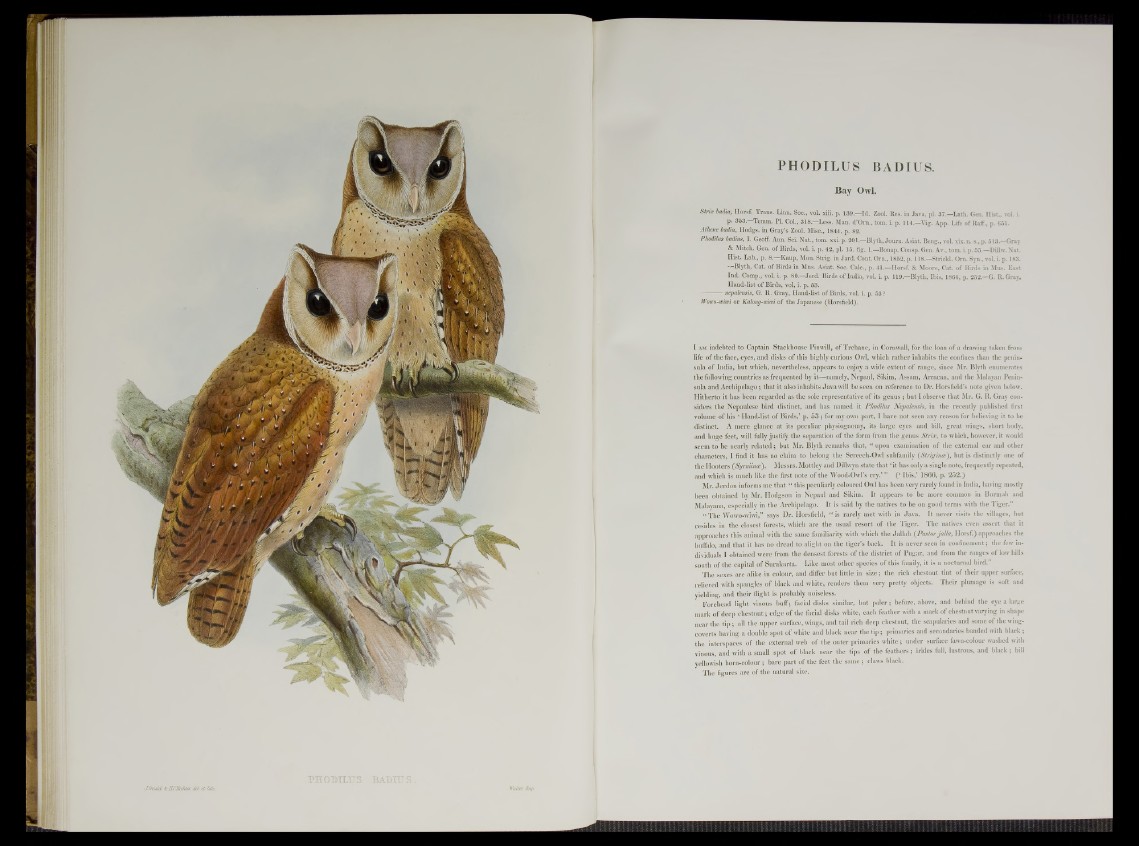
J.CmdcL tsRCMekta; deb eb HÜv.
PHOMLTTS BATHTTT
Walter, Im p,
PHODILUS BADIUS.
Bay Owl.
Strix badia, Horsf. Trans. Linn. Soc., vol. xiii. p. 139.—Id. Zool. Res. in Java, pi. 37.—Lath. Gen. Hist., vol. i.
p. 353.—Temm. PI. Col., 318.—Less. Man. d’Orn., tom. i. p. 114—Vig. App. Life of Raff., p. 651.
Athene badia, Hodgs. in Gray’s Zool. Misc., 1844, p. 82.
Phodilm badius, I. Geoff. Ann. Sci. Nat., tom. xxi. p. 201.—Blyth, Journ. Asiat. Beng., vol. xix. n. s., p. 513.—Gray
& Mitch. Gen. of Birds, vol. i. p. 42, pi. 15. fig. 1.—Bonap. Consp. Gen. Av., tom. i. p. 55.—Dillw.Nat.
Hist. Lab., p. 8.—Kaup, Mon. Strig. in Jard. Cont. Orn., 1852, p. 118.—Strickl. Om. Syn., voi, i. p. 183.
—Blyth, Cat. of Birds in Mus. Asiat. Soc. Calc., p. 41.—Horsf. & Moore, Cat. of Birds in Mus. East
Ind. Comp., vol. i. p. 80.—Jerd. Birds of India, vol. i. p. 119.—Blyth, Ibis, 1866, p. 252.—G. R.Gray,
Hand-list of Birds, voi, i. p. 53.
----------nepalensis, G. R. Gray, Hand-list of Birds, vol. i. p. 53 ?
Wowo-wiwi or Kalong-wiwi of the Japanese (Horsfield).
I a m indebted to Captain Stackhouse Pinwill, of Trehane, in Cornwall, for the loan of a drawing taken from
life of the face, eyes, and disks of this highly curious Owl, which rather inhabits the confines than the peninsula
of India, but which, nevertheless, appears to enjoy a wide extent of range, since Mr. Blyth enumerates
thefollowing countries as frequented by it—namely, Nepaul, Sikim, Assam, Arracan, and the Malayan Peninsula
and Archipelago; that it also inhabits Java will be seen on reference to Dr. Horsfield’s note given below.
Hitherto it has been regarded as the sole representative of its genus ; but I observe that Mr. G. R. Gray considers
the Nepaulese bird distinct, and has named it Phodilus Nepalensis, in the recently published first
volume of his ‘ Hand-list of Birds,’ p. 53; for my own part, I have not seen any reason for believing it to be
distinct. A mere glance at its peculiar physiognomy, its large eyes and bill, great wings, short body,
and huge feet, will fully justify the separation of the form from the genus Strix, to which, however, it would
seem to be nearly related; but Mr. Blyth remarks that, “ upon examination of the external ear and other
characters, I find it has no claim to belong the Screech-Owl subfamily (Strigbice), but is distinctly one of
the Hooters (SyrniincB). Messrs. Mottley and Dillvvyn state that ¡it has only a single note, frequently repeated,
and which is much like the first note of the Wood-Owl’s cry.” ’ (‘ Ibis,’ 1866, p. 252.)
Mr. Jerdon informs me that “ this peculiarly coloured Owl has been very rarely found in India, having mostly
been obtained by Mr. Hodgson in Nepaul and Sikim. It appears to be more common in Burmah and
Malayana, especially in the Archipelago. It is said by the natives to be on good terms with the Tiger.”
“ The Wowo-wiwb” says Dr. Horsfield, “ is rarely met with in Java. It never visits the villages, but
resides in the closest forests, which are the usual resort of the Tiger. The natives even assert that it
approaches this animal with the same familiarity with which the Jallah (Pastor jalla, Horsf.) approaches the
buffalo, and that it has no dread to alight on the tiger’s back. It is never seen in confinement; the few individuals
I obtained were from the densest forests of the district of Pugar, and from the ranges of low hills
south of the capital of Surakarta. Like most other species of this family, it is a nocturnal bird.”
The sexes are alike in colour, and differ but little in size; the rich chestnut tint of their upper surface,
relieved with spangles of black and white, renders them very pretty objects. Their plumage is soft and
yielding, and their flight is probably noiseless.
Forehead light vinous buff; facial disks similar, but paler; before, above, and behind the eye a large
mark of deep chestnut; edge of the facial disks white, each feather with a mark of chestnut varying in shape
near the tip ; all the upper surface, wings, and tail rich deep chestnut, the scapularies and some of the wing-
coverts having a double spot of white and black near the tip; primaries and secondaries banded with black;
the interspaces of the external web of the outer primaries white; under surface fawn-colour washed with
vinous, and with a small spot of black near the tips of the feathers; irides full, lustrous, and black; bill
yellowish horn-colour; bare part of the feet the same ; claws black.
The figures are of the natural size.
Ü If 11